I had the pleasure recently of rewatching "The Golden Compass". It is not a perfect film, if such a thing exists, but it is a serviceable enough adaptation of the first book of Philip Pullman's trilogy. Even more recently I reviewed the first five "Harry Potter" movies. While watching "Harry Potter and the Order of the Phoenix" it struck me how very similar the concepts of Pullman's Daemons and Rowling's Patronus Charm really are.
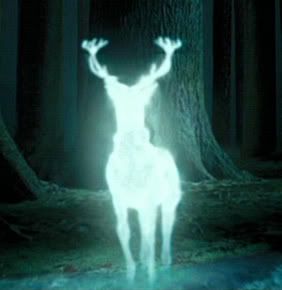 Harry's Patronus from "Prisoner of Azkaban", a stag related to his father's animagus form
Harry's Patronus from "Prisoner of Azkaban", a stag related to his father's animagus form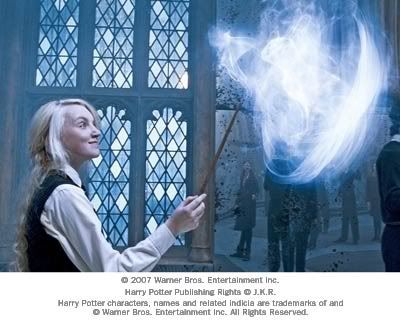
Luna Lovegood manifests a fully name appropriate rabbit Patronus
Harry teaches Dumbledore's Army the art of the Patronus Charm
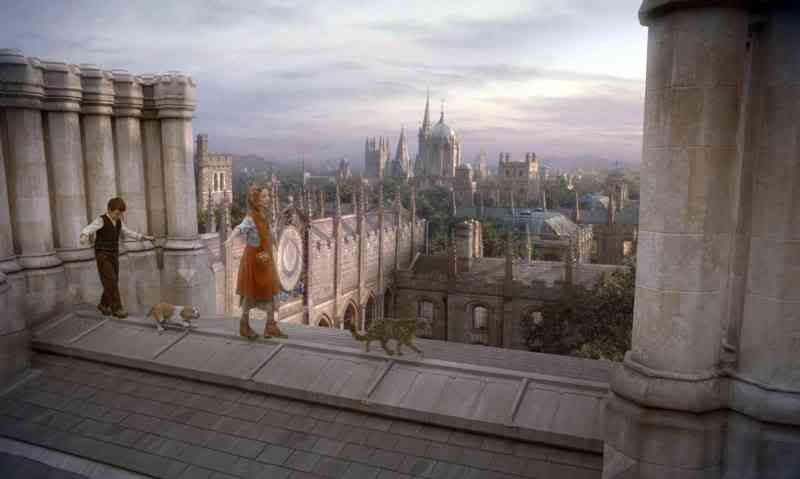
Lyra and Roger with their Daemons Pantalaimon and Salcilia

Lyra and Pantalimon with Fader Corum and his Daemon Sophonax
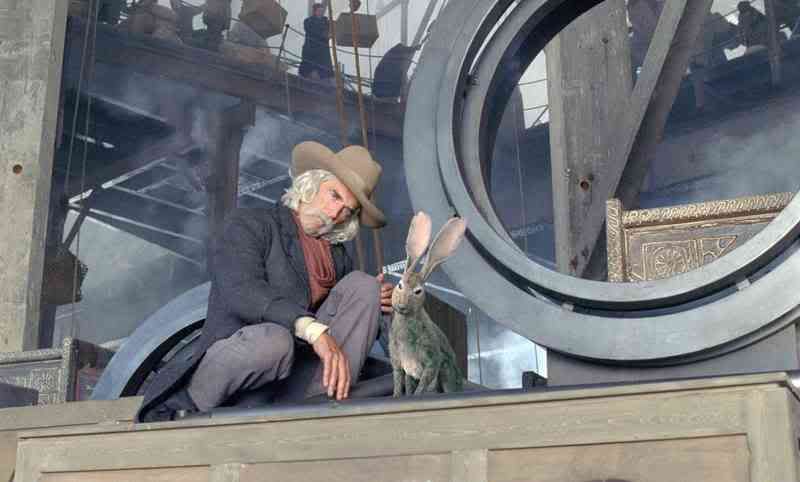
The aeronaut Lee Scoresby and Hester
It is possible that one inspired the other. "Northern Lights" was first published in 1995, two years before "Harry Potter and the Philosopher's Stone", and four years before the Patronus Charm was introduced in "Harry Potter and the Prisoner of Azkaban". After its introduction the Patronus figures became one of the more prominent magical manifestations of the series, associated almost exclusively with the good guys. They are particularly visible in Part 5 as one of their primary functions is as protection from the Dementors, also returning from Part 3, entities clearly informed by Tolkien's Ringwraiths.
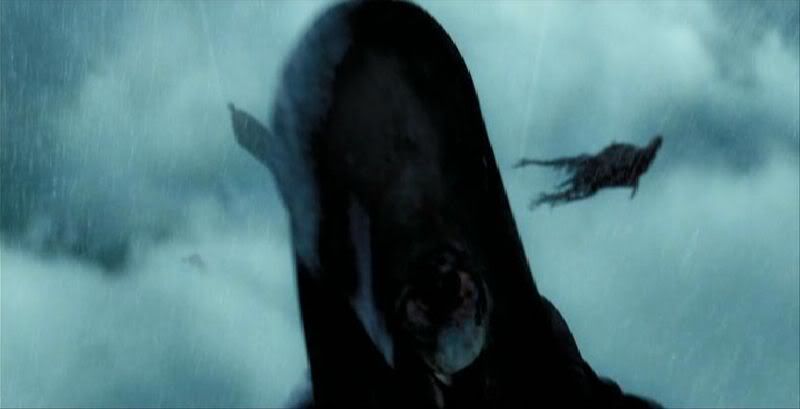
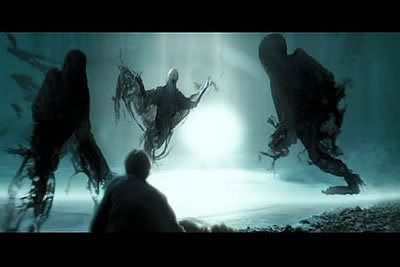
Dementors as seen in "Harry Potter and the Prisoner of Azkaban"
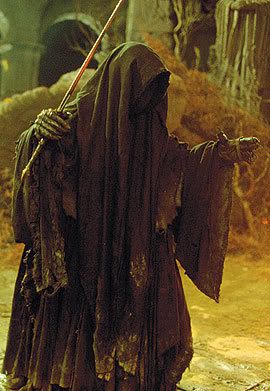
A Ringwraith from "The Fellowship of the Ring"
In fact there is no real need to determine which author devised which notions first as they all draw upon occult symbolic motifs of ancient origin, found multiculturally. There is a nice list of related concepts in the "See Also" section of the Wikipedia Daemon article. Particularly interesting is the similarity to the Norse Fylgja story, especially for those who have read the rest of Pullman's trilogy. And everyone is familiar with the Familiar, as a witch's black cat if nothing else. Daemons and the Patronus Charm are both extrapolations of this lore.
When I started preparing this article I did not expect Leonardo da Vinci to be a part of the topic, and yet I can no longer say I am surprised when he turns up in unexpected ways. In retrospect his presence in this matter makes perfect sense as I hope to demonstrate. As I learned from Wikipedia, in an interview for More Intelligent Life.com Philip Pullman credits the concept of the daemons to three particular portraits by great masters of the Renaissance and Baroque eras.
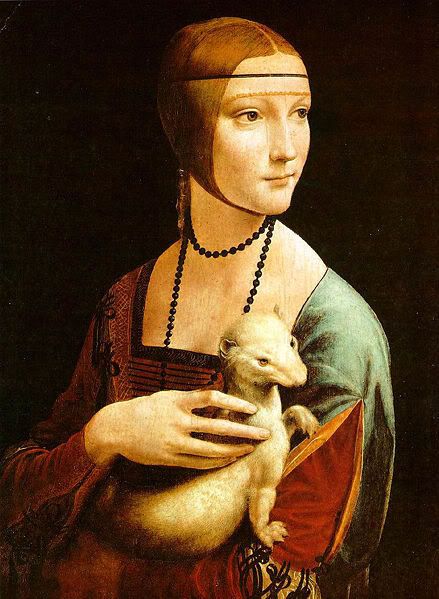
Leonardo da Vinci, "Lady with an Ermine" c. 1489-1490
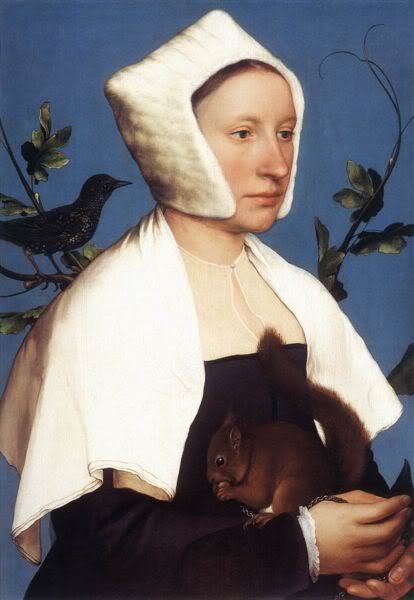 Hans Holbein the Younger, "Lady with a Squirrel" c. 1526-28
Hans Holbein the Younger, "Lady with a Squirrel" c. 1526-28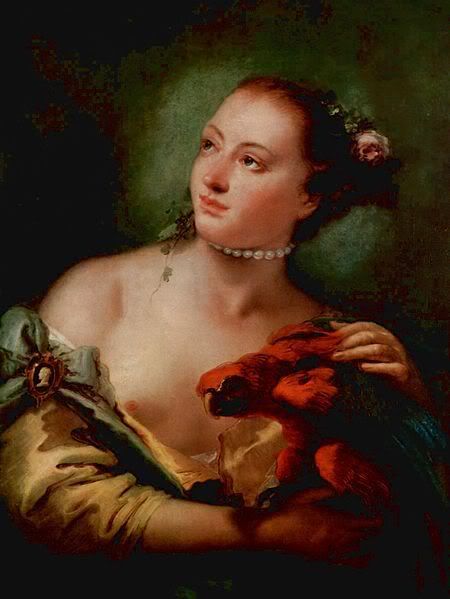 Giovanni Battista Tiepolo, "Young Lady with a Parrot" c. 1758-60
Giovanni Battista Tiepolo, "Young Lady with a Parrot" c. 1758-60And how Pullman derived his story device from consideration of these works is easy to follow as the coupling of a portrait subject to an animal in this manner is the artist depicting a "Daemon", a symbol of the sitter's persona. But of course with Da Vinci things go deeper. Here's a well-known self portrait of Da Vinci from around 1512-15 followed by a few of his more famous followers.
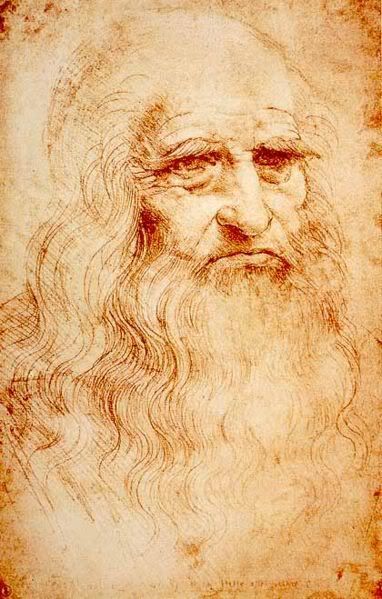
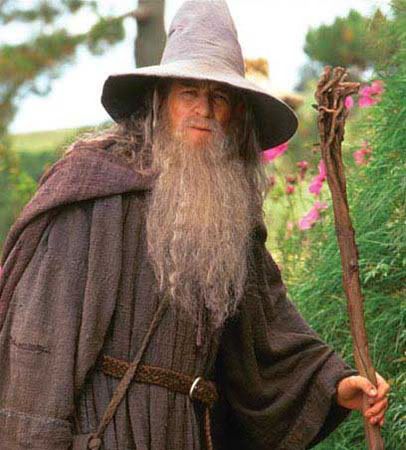
Ian McKellan as Gandalf in "The Fellowship of the Ring"

Richard Harris as Dumbledore in "Harry Potter and the Philosopher's Stone"
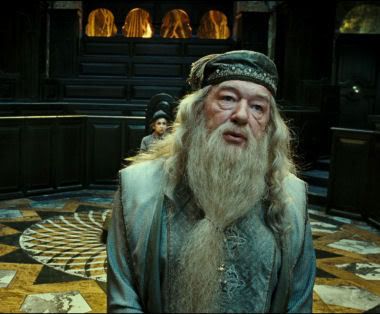
Michael Gambon as Dumbledore in "Harry Potter and the Order of the Phoenix"
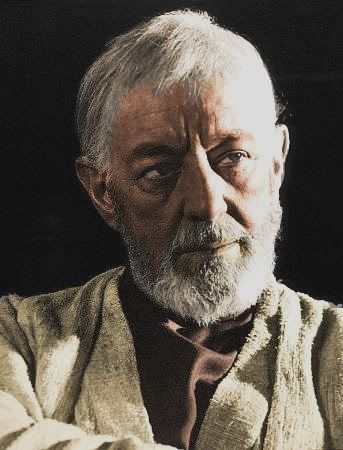
Alec Guiness as Obi-Wan Kenobi in "Star Wars Episode IV: A New Hope"
Of course all of these fictional old wizards look very similar, as they all represent the light-father and supernatural mentor figure of the monomythic Hero's Journey. And again, Gandalf clearly well predated and openly inspired Obi-Wan and Dumbledore. Of course all bear a clear similarity to other famous historical wizards like John Dee and Nicholas Flamel and to traditional depictions of legendary/mythological figures like Merlin the Magician.
In the case of the "Harry Potter" series the Arthurian elements are not even veiled as the term "Merlin" is used as a kind of wizard ranking, with Albus Dumbledore described as being of the "Order of Merlin First Class" (as well as being described as a "Mugwump", see Tingly Intuition). The great Richard St. John Harris then in his career graduated from being King Arthur on stage and screen versions of "Camelot" to a Merlin-figure in the first two Harry Potter movies.
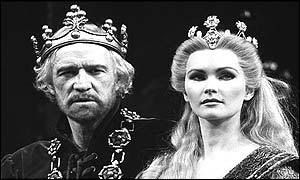
Richard Harris as Arthur in a stage production of "Camelot"
If the roles played by actors color or otherwise inform their other performances, then things get even more interesting with Dumbledore with Harris' replacement Michael Gambon. Mostly this just makes Dumbledore creepier. A few months ago I caught Gambon playing a crime lord with the great name of Eddie Temple in "Layer Cake", costarring current James Bond (thus John Dee resonant) Daniel Craig, and directed by Matthew Vaughn who also brought us last year's adaptation of "Stardust". You might agree that Gambon's role in Robert De Niro's "The Good Shepherd" is very intriguing viewed through a Harry Potter lens. But what I'm really shocked by was learning that Michael Gambon was the Thief, Albert Spica, in the 1989 film "The Cook, The Thief, His Wife & Her Lover".
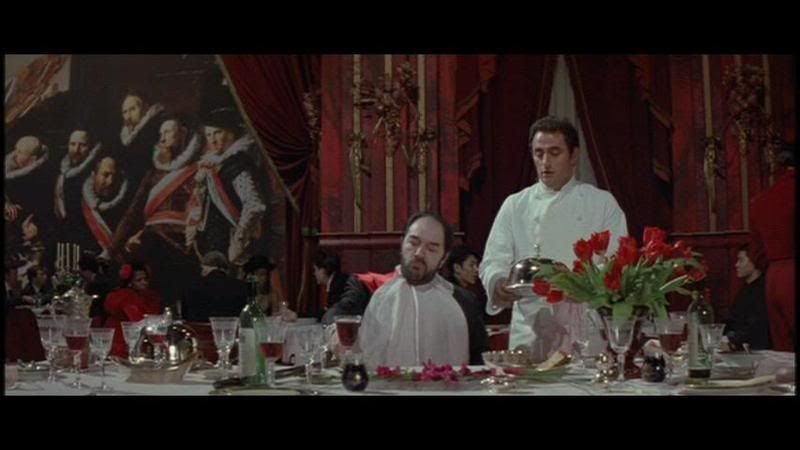
I'll never look at Dumbledore the same way now that I realize this. Have you seen this film? You should, but only if you appreciate lush, exquisitely crafted nightmares, to the fullest connotation of that term.
All of the works listed at the start of this article follow the same essential monomythic solar allegory hero's journey, which as stated involves the protagonist being assisted by a magical entity, usually an elderly male, great warrior and/or wizard. In "The Golden Compass" this role is largely filled by the armored polar bear Iorek Byrnison.

The voice of Iorek was provided by Gandalf portrayer Ian McKellan. McKellan was also the narrator of "Stardust". In the film version of "Stardust" the magical patriarch role comes in the form of the gay sky-pirate Captain Shakespeare, played by Robert De Niro. Of course "The Golden Compass" also featured Daniel Craig as Lord Asriel. Craig is currently slated to appear as Bond at least two more times, in this year's "Quantum of Solace" and then the 23rd Bond film "Skyfall."
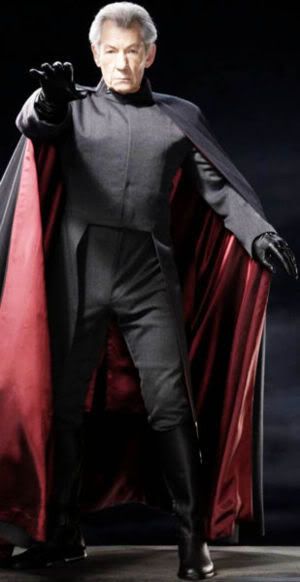
McKellan also played Magneto in the three X-Men films, which is essentially the same magical mentor/patriarch figure in retrograde, the antagonist rather then the protagonist. Magneto might be the villain, but his character is much more akin to Dumbledore and Gandalf than Voldemort and Sauron. The other role of McKlellan's that I find most pertinent was as Sir Leigh Teabing in the 2006 adaptation of "The Da Vinci Code".
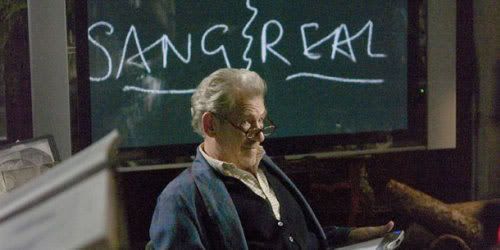
A part which you might agree involves these key aspects in more then one way if you're familiar with the story. Of course "The Da Vinci Code" involves the list of Grand Masters of the Priory of Sion used for Lincoln, Leigh and Baigent's "The Holy Blood and the Holy Grail", which includes Da Vinci as well as Nicolas Flamel, a friend and associate of Albus Dumbledore in "Harry Potter and the Philosopher's Stone".
"The Da Vinci Code" was directed by Ron Howard. One of Howard's film roles as an early adult was in George Lucas' 1973 coming-of-age movie "American Graffiti". Lucas and Howard teamed again when Howard directed Lucas' magical fantasy adventure "Willow" in 1988. Note how "Willow" is essentially the same story as Star Wars, beyond both following the monomyth, it is again more or less a treatment of Kurosawa's "The Hidden Fortress", and indeed, one of Lucas' early concepts for Star Wars involved Luke Skywalker being a little person, showing the Tolkien influence. And since we're talking about Lord of the Ring influences on Star Wars, note how Christopher Lee's roles in these films as Saruman and Count Dooku are virtually identical in almost every way, with the characters' primary roles occurring in the second installments of the trilogies, "Attack of the Clones" and "The Two Towers", both released in 2002.
Now, check out this section of "The Fellowship of the Ring" featuring Bilbo's birthday party.
Mischeif makers Merry and Pippin get into Gandalf's firework stash, and set off one that creates a convincing pyrotechnic dragon (approx. 2 minutes in).
This scene is then paid tribute in "Harry Potter and the Order of the Phoenix" when mischief makers Fred and George Weasley disrupt examinations with a fireworks display, including a convincing pyrotechnic dragon.
That's Charms Professor Flitwick who gives the little, sneaky cheer as the giant W (for Weasley) ignites in the sky. Flitwick is played by Warwick Davis. He's seen here in his more interesting presentation from the third film on. In the first two movies he looked more like Dumbledore's Mini Me.
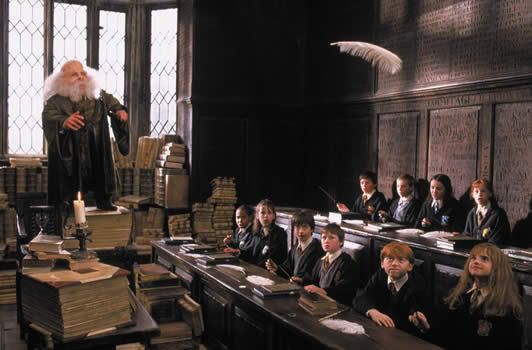
Wingardium Leviosa
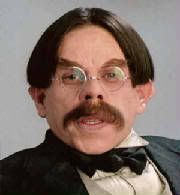
Davis was also the aforementioned Willow Ufgood in the Howard/Lucas film.
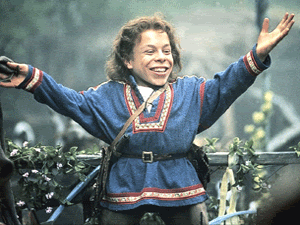
His first role was playing the Ewok Wicket W. Warwick in "Star Wars Episode VI: Return of the Jedi". He also had two bit parts in "The Phantom Menace", as Anakin's Rodian friend W. Wald and as an associate of Anakin's owner Watto named Weazel (close to Weasley).
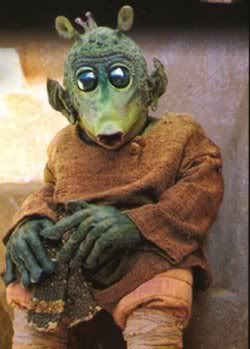
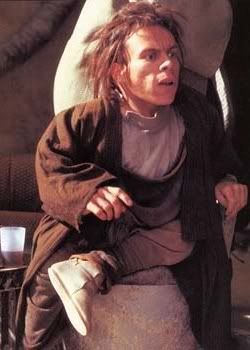
In fact all of Davis roles in Lucas productions involve characters whose names start with W. No wonder he cheers the insignia. The W in "Order of the Phoenix" can also be seen as a reversal or opposition of the M utilized as a logo for the Ministry of Magic. Magneto is likewise often depicted using a simple M as a logo. Those familiar with "The Da Vinci Code" will recall Da Vinci's cryptic use of the M in the composition of his "The Last Supper", perhaps a reference to Mary Magdalene. It's worth noting that M is the 13th letter of the alphabet and W the 23rd, both highly significant occult numbers.
Going back to the Da Vinci self-portrait, it is conceivable that this image is itself allegorical in nature. Da Vinci has been similarly presented in Venetian master Giorgione's c. 1508-09 work "The Three Philosophers".
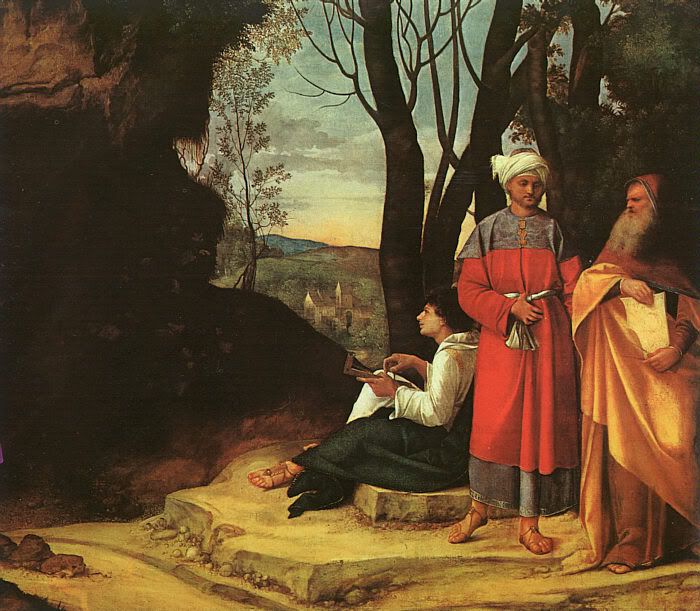
Some regard this as an allegorical portrait of (from left to right) Giorgione, Hieronymous Bosch and Leonardo da Vinci. That these depictions are largely meant to be symbolic can be attested by the fact that Bosch and Da Vinci were roughly the same age despite Da Vinci here appearing to be far more elderly. Note too Giorgione's compass and square.
So this image of Da Vinci as a wizened, hermetic magician might have been just as cultivated and manufactured to confer symbolic meaning and role as the appearance of Gandalf, Dumbledore or Obi-Wan, all drawing from a greater occult tradition. Tolkien attested to the basis of Gandalf on the Wanderer form of the Norse god Odin. For his visual inspiration Tolkien cited a postcard that has been revealed to be the work of German artist Josef Madlener.
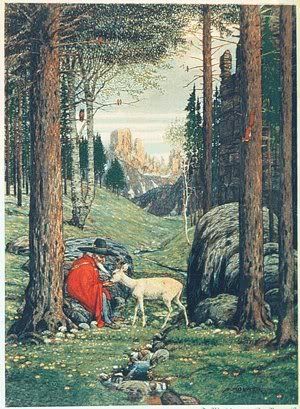
"Der Berggeist" (The Mountin Spirit), c. 1925-30
Madlener's daughter describes the image as a part of a series depicting Germanic folktales. So even if this does not directly represent Odin it still connects to traditions associated with him and his worship.
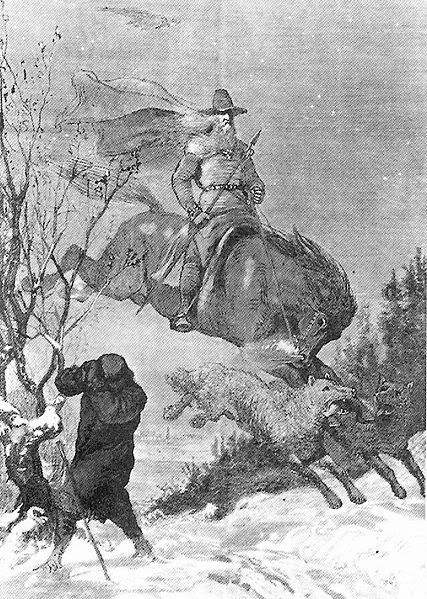
August Malmström, "Odin and the Wild Hunt"
It is not at all difficult to view the above illustration as Dumbledore driving off a Dementor or Gandalf fighting a Ringwraith. As stated many times before, Odin represents the planet Mercury and is the Norse correspondent of wisdom/knowledge deities Thoth/Hermes/Mercury/Nabu, also associated with the planet. So it should not be surprising, as with the Malmström illustration above, that Odin is at times depicted in almost exactly the same manner as the legendary figure of Hermes Trismegistus.
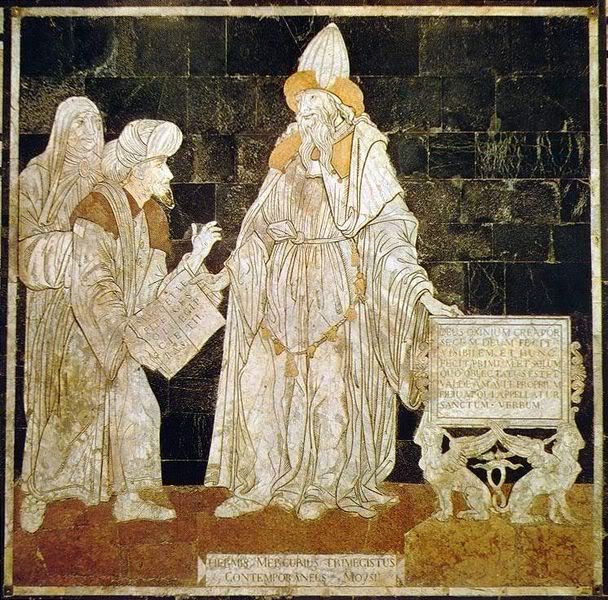
A floor mosaic from Duomo di Siena
He looks very familiar to me.